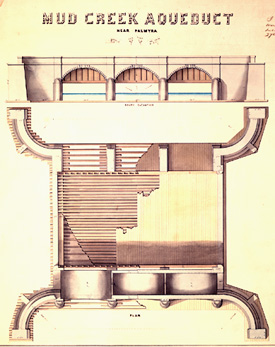

The purpose of an aqueduct is to carry the canal and its towpath over a river, a ravine, a railroad, or a road. Typically, the towpath is carried across an aqueduct on stone arches, while the canal itself is carried across in an adjacent heavily-braced wooden trough resting on stone piles.
This aqueduct was built near Palmyra, NY. The drawing at the top, shows the aqueduct looking north up the river (shown in blue at the bottom), with the canal passing from side to side through the wooden trough. Parts of the trough (represented in brown), are visible through the twenty-four foot wide stone arches (represented in gray).
The main drawing below, shows the aqueduct viewed from above, carrying the canal from side to side. In the center of the drawing is the planking of the canal trough itself (represented in yellow, shaded brown at the bottom for shadow), resting on beams. The gray three-sectioned feature shown below the trough planking represents the three arches. The abutments, curving out at the corners, provide lateral strength for the structure at its ends.
At the left, the transverse section, placed on its side, shows the view looking down the canal, portrayed in blue at the top, with the towpath adjacent to the channel at the left of the drawing.
http://www.eriecanal.org/UnionCollege/The_Aqueduct.html